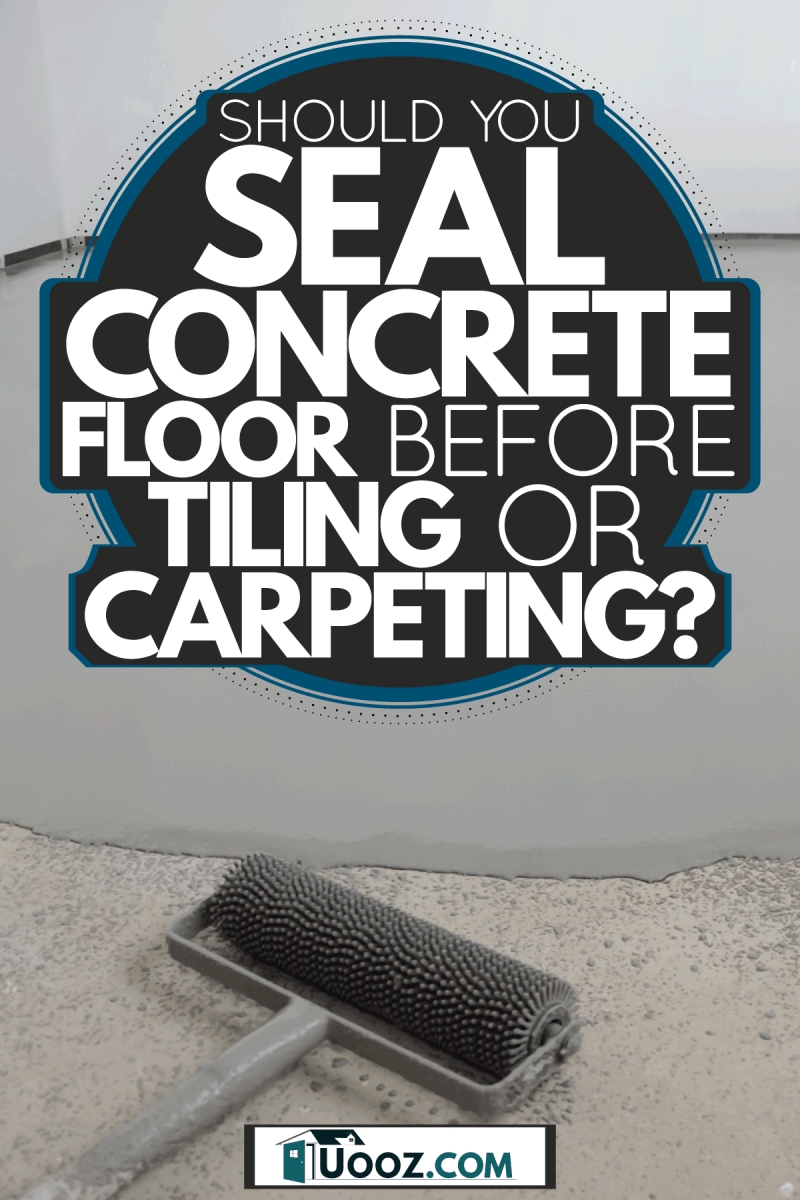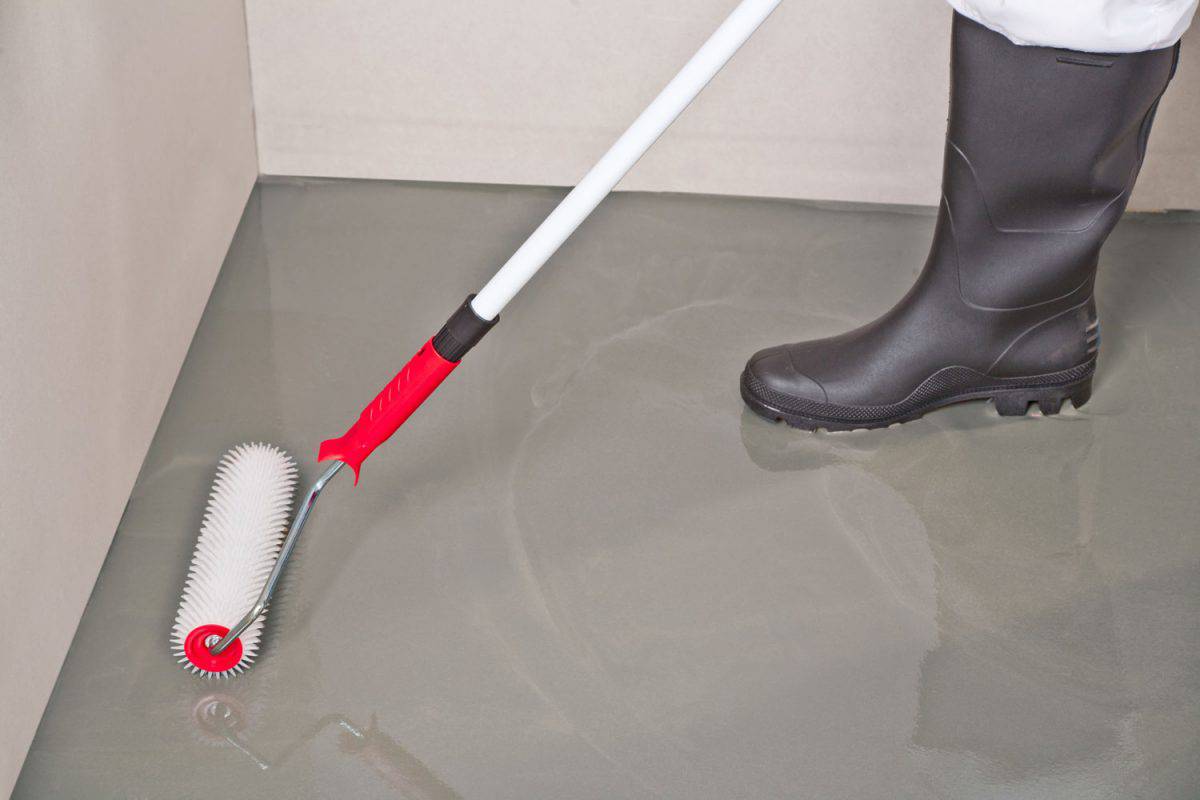Adding carpet or tile over a concrete floor is a great way to help insulate your home. Most often, concrete floors are found in a basement, which we all know can be prone to excessive moisture and flooding. This raises the question of whether or not you should seal the concrete floor before adding that carpet or tile. We've done the searching for you and have some excellent information.
Sealing a concrete floor before covering it with tile or carpet is a great idea. Sealing the concrete can prevent condensation and protect the floor. This means your carpet or tile stays dry and thus lowers the chances of mold and mildew building up.
Now that you know that it's definitely best to seal the concrete floor before covering it with carpet or tile, let's get into all the details. We'll answer some additional questions you might have as well. Without further ado, let's get into it!

Sealing A Concrete Floor
Here we'll discuss the basics of sealing a concrete floor in greater detail. But first, we'll talk about some important background information that makes sealing a concrete floor a good idea.
Why Are Basements Wet?
Basements are generally completely underground. This means the walls and the floors of a basement are much cooler than the air. When the warmer air makes contact with the cold surfaces, condensation occurs, similar to what you see happen on a cold beverage on a warm day. In addition to the contrast of temperatures, sometimes basements are prone to flooding or excess runoff since water tends to flow to the lowest point of any given area.
What Happens When Moisture Builds
If moisture is allowed to build up unchecked, it can lead to the growth of bacteria, mold, and mildew. This is what causes that musty scent so many basements are known for. Not only can it make the smell of your basement less than desirable, but it can also create slippery surfaces that can be a fall hazard, make permanent water stains, or cause corrosion of anything metal kept in the basement.
Why Mold And Mildew Are Bad
The gases released by harmful bacteria and mold can cause the air inside a building to essentially become toxic. Left to grow, the mold can cause respiratory issues, especially to those with asthma, allergies, or other respiratory conditions. If the problem is bad enough, it could lead to more serious conditions like cancer, birth defects, or severe respiratory distress.
How Does The Sealant Work?
The way sealant adheres to and protects your floors is a pretty simple concept. The sealant fills up the pores on the surface of the floor with polymer molecules, closing them off to moisture, dirt, and debris. The sealant will wear down over time, so it's important to apply enough before putting down carpet or tile since it won't be easy to reapply the sealant.

How Do You Seal A Concrete Floor?
Sealing a concrete floor is a fairly simple process. Before getting started, be sure to have all the necessary equipment and products readily available.
These are the tools you'll need for the project:
- Degreaser
- Broom
- Mop and floor cleaner
- Paint roller with a long handle
- Paintbrush
- Sealer of choice
- Paint tray
- Putty knife and concrete repair mix (optional)
1. Repair Any Cracks Or Chips On The Floor
Before applying the sealant, you must ensure you have a clean, even surface to which you'll apply the product. If you have any cracks or chips in the concrete, you'll want to repair these and allow them to dry first. There are plenty of concrete repair products, such as this two-part epoxy:
With this product, you just inject the epoxy into the crack or chip and smooth it with a putty knife. Be sure to allow the repair to fully dry and cure before applying sealant. To find out how long you'll need to wait, pay close attention to the manufacturer's instructions.
View this concrete repair on Amazon.
2. Clean The Floor
Your floor needs to be spotless before applying the sealant. Using your broom, thoroughly sweep up any debris, dirt, and dust from the floor. Look for any sticky or greasy spots and use a degreaser to make sure it's squeaky clean.
View this degreaser on Amazon.
As a final cleaning step before applying the sealant, give the floor a thorough mopping and allow it to fully dry.
View this floor cleaner on Amazon.
3. Apply Sealant
Once you're certain the floor is totally dry, put your sealant in the paint tray. Many sealants are available, but we recommend using one specifically for concrete so you know it will properly fill the pores of the concrete floor.
Since this sealant is a concentrate, it makes about five gallons of sealant. One gallon of sealant will cover anywhere from 250 to 500 square feet of your floor depending on the porosity of your floor, so this should be plenty to get the job done.
View this concrete floor sealer on Amazon.
Using your paint roller with a long handle, apply the sealant to the floor, using the paintbrush to get the corners. Be sure not to box yourself in as you work!
View this paint roller on Amazon.
4. Repeat
Leave your sealant to dry for at least two hours, and then apply a second coat in the same manner as the first. This ensures your entire floor is completely covered and well protected.
5. Dry Completely
Allow the floor to dry completely before walking across it as normal or applying the carpet or tile. Read the manufacturer's instructions for accurate drying and curing time, as it can take up to several days.
Want to read more about floor sealant and how long it might take to dry? Check out this post: How Long Does It Take For Floor Sealant To Dry?
Can You Put Carpet Directly On Concrete?
You can put carpet directly over concrete, but there are a few caveats. Understand that, without padding, the carpet will not be as soft as it is in other parts of your home. The carpet will basically be a buffer between the concrete and you. Additionally, you'll need to ensure you get the proper adhesive to attach the carpet to the floor, as the carpet won't have the padding underneath to supply any type of grip. Use carpet glue liberally to ensure it sticks.
View this carpet glue on Amazon.
Keep in mind if you're still worried about moisture even after sealing the concrete floor, it is best to have some kind of underlayment between the carpet and floor — having the carpet on a raised, dimpled surface can encourage airflow and help prevent mold build-up.

What Should You Put Between Carpet And Concrete?
Synthetic underlayment is the best thing to put between the carpet and concrete. Even after sealing, basements are prone to moisture, so that extra layer between the carpet and floor can help discourage the moisture build-up. Having something between the carpet and floor adds some extra padding as well, so the basement has the potential to be a little cozier.
This underlayment is recommended under tile or stone, however, it's made of a waterproof material which makes it ideal for basements.
View this underlayment on Amazon.
Can You Tile Directly Onto Concrete?
You can definitely put tile directly onto concrete. These two materials often work well together, as they are both unforgiving materials. Tiles need a solid, even surface for installation, so concrete is a good choice.
The only downside to installing tile directly to concrete is that concrete is prone to cracking and chipping over time. Concrete basement floors are notorious for cracking with the slightest foundational shift, and they are even apt to be cracked by growing tree roots. Anything that happens to your concrete floor will also happen to the tile placed on top of it.
The underlayment linked above, known as an uncoupling membrane, is great to use between tile and concrete, as it can help the tile stay intact even if the concrete cracks.
In Closing
To protect the longevity and health of your household, it is definitely recommended to seal your concrete floors before covering them with tile or carpet. It's an inexpensive, straightforward way to protect your concrete floor and the flooring you're installing over it.
Are you trying to find out if you can add hardwood over concrete? Check out this post: Can You Float A Hardwood Floor Over Concrete?







